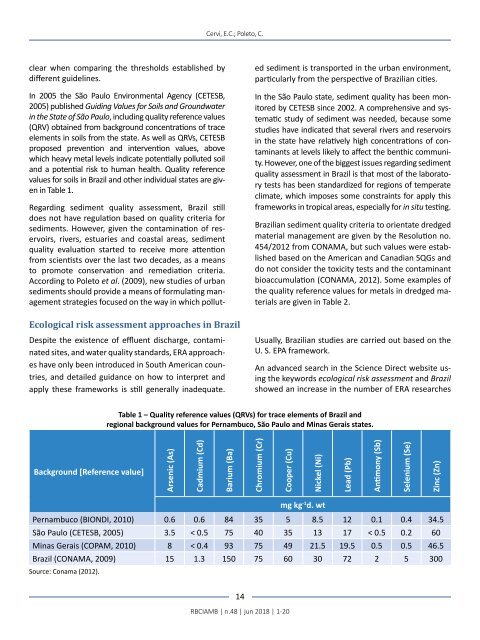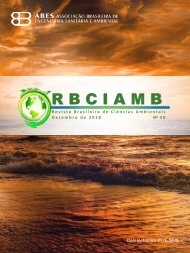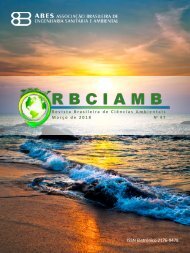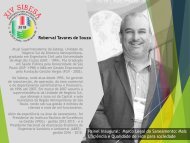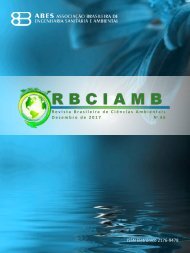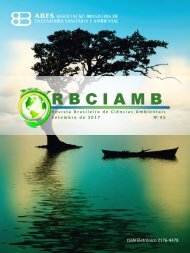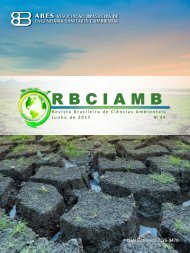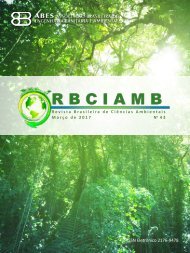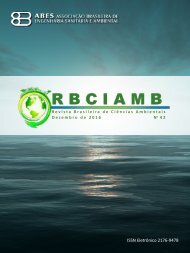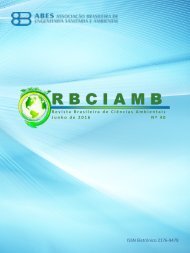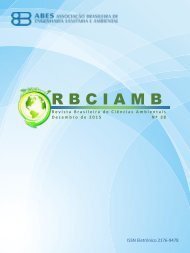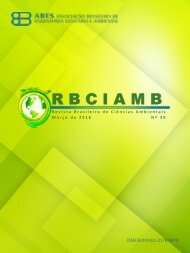Edição 48 RBCIAMB
You also want an ePaper? Increase the reach of your titles
YUMPU automatically turns print PDFs into web optimized ePapers that Google loves.
Cervi, E.C.; Poleto, C.<br />
clear when comparing the thresholds established by<br />
different guidelines.<br />
In 2005 the São Paulo Environmental Agency (CETESB,<br />
2005) published Guiding Values for Soils and Groundwater<br />
in the State of São Paulo, including quality reference values<br />
(QRV) obtained from background concentrations of trace<br />
elements in soils from the state. As well as QRVs, CETESB<br />
proposed prevention and intervention values, above<br />
which heavy metal levels indicate potentially polluted soil<br />
and a potential risk to human health. Quality reference<br />
values for soils in Brazil and other individual states are given<br />
in Table 1.<br />
Regarding sediment quality assessment, Brazil still<br />
does not have regulation based on quality criteria for<br />
sediments. However, given the contamination of reservoirs,<br />
rivers, estuaries and coastal areas, sediment<br />
quality evaluation started to receive more attention<br />
from scientists over the last two decades, as a means<br />
to promote conservation and remediation criteria.<br />
According to Poleto et al. (2009), new studies of urban<br />
sediments should provide a means of formulating management<br />
strategies focused on the way in which polluted<br />
sediment is transported in the urban environment,<br />
particularly from the perspective of Brazilian cities.<br />
In the São Paulo state, sediment quality has been monitored<br />
by CETESB since 2002. A comprehensive and systematic<br />
study of sediment was needed, because some<br />
studies have indicated that several rivers and reservoirs<br />
in the state have relatively high concentrations of contaminants<br />
at levels likely to affect the benthic community.<br />
However, one of the biggest issues regarding sediment<br />
quality assessment in Brazil is that most of the laboratory<br />
tests has been standardized for regions of temperate<br />
climate, which imposes some constraints for apply this<br />
frameworks in tropical areas, especially for in situ testing.<br />
Brazilian sediment quality criteria to orientate dredged<br />
material management are given by the Resolution no.<br />
454/2012 from CONAMA, but such values were established<br />
based on the American and Canadian SQGs and<br />
do not consider the toxicity tests and the contaminant<br />
bioaccumulation (CONAMA, 2012). Some examples of<br />
the quality reference values for metals in dredged materials<br />
are given in Table 2.<br />
Ecological risk assessment approaches in Brazil<br />
Despite the existence of effluent discharge, contaminated<br />
sites, and water quality standards, ERA approaches<br />
have only been introduced in South American countries,<br />
and detailed guidance on how to interpret and<br />
apply these frameworks is still generally inadequate.<br />
Usually, Brazilian studies are carried out based on the<br />
U. S. EPA framework.<br />
An advanced search in the Science Direct website using<br />
the keywords ecological risk assessment and Brazil<br />
showed an increase in the number of ERA researches<br />
Table 1 – Quality reference values (QRVs) for trace elements of Brazil and<br />
regional background values for Pernambuco, São Paulo and Minas Gerais states.<br />
Background [Reference value]<br />
Arsenic (As)<br />
Cadmium (Cd)<br />
Barium (Ba)<br />
Chromium (Cr)<br />
Cooper (Cu)<br />
Nickel (Ni)<br />
Lead (Pb)<br />
Antimony (Sb)<br />
Selenium (Se)<br />
Zinc (Zn)<br />
mg kg -1 d. wt<br />
Pernambuco (BIONDI, 2010) 0.6 0.6 84 35 5 8.5 12 0.1 0.4 34.5<br />
São Paulo (CETESB, 2005) 3.5 < 0.5 75 40 35 13 17 < 0.5 0.2 60<br />
Minas Gerais (COPAM, 2010) 8 < 0.4 93 75 49 21.5 19.5 0.5 0.5 46.5<br />
Brazil (CONAMA, 2009) 15 1.3 150 75 60 30 72 2 5 300<br />
Source: Conama (2012).<br />
14<br />
<strong>RBCIAMB</strong> | n.<strong>48</strong> | jun 2018 | 1-20


